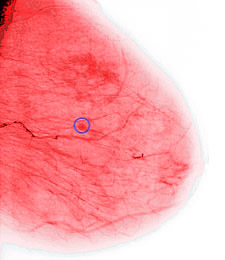Apr 11 2005
 Since 1980, the incidence of ductal carcinoma in situ, or DCIS, one of the most common kinds of early stage breast cancer, has increased more than sevenfold. This sharp increase in DCIS – which is a tumor that contains cancer-like cells but is not considered "true" cancer because the cells have not invaded normal breast tissue – has been accompanied by a flattening in the incidence of true invasive breast cancer.
Since 1980, the incidence of ductal carcinoma in situ, or DCIS, one of the most common kinds of early stage breast cancer, has increased more than sevenfold. This sharp increase in DCIS – which is a tumor that contains cancer-like cells but is not considered "true" cancer because the cells have not invaded normal breast tissue – has been accompanied by a flattening in the incidence of true invasive breast cancer.
Both trends suggest that widespread mammography screening, along with improvements in imaging technology and increased biopsy rates, among other factors, are catching breast cancer earlier, before it starts to spread and becomes more life-threatening, according to a new study by Christopher Li, M.D., Ph.D., and colleagues at Fred Hutchinson Cancer Research Center, published in the April issue of Cancer Epidemiology, Biomarkers and Prevention.
"The results of this study suggest that our public-health efforts to increase the use of breast-cancer screening – mammography, primarily – appear to have altered the types of breast cancer that are being diagnosed most frequently in the United States, as we have found that the number of invasive cases being diagnosed has stabilized, while more cases of in situ breast cancer are being diagnosed," said Li, an assistant member of Fred Hutchinson's Public Health Sciences Division.
Li and colleagues also found a sixfold increase in a less aggressive form of ductal carcinoma in situ, a condition called noncomedo DCIS, while incidence rates of a potentially more aggressive type, called comedo DCIS, have declined during the last five years.
"This suggests a further downshifting of severity within in situ cancers themselves," Li said.
The researchers also found that rates of a less common precancerous condition called lobular carcinoma in situ, or LCIS, has increased nearly fourfold in postmenopausal women since 1980.
These findings, based on the most comprehensive assessment to date of age-specific incidence rates of in situ breast cancer, while encouraging, also pose a particular challenge to health-care professionals.
"There is good news in that it appears we are detecting breast cancer at an earlier stage. However, the increasing number of in situ cancers presents an important clinical challenge, since in some cases the treatments that should be given to women with these conditions, primarily LCIS, is unclear," Li said. "Another problem is that we are not very good at predicting which women with these precancerous lesions will develop invasive breast cancer and which will not," said Li, also a research assistant professor in the Department of Epidemiology at the University of Washington School of Public Health and Community Medicine.
Since lobular carcinoma in situ, or LCIS, is very rare, accounting for only about 4,200 cases annually in the United States, it has not been possible to gather enough cases to conduct randomized clinical trials to determine whether women would benefit from treatment.
"Some small studies do indicate that women with LCIS are equally likely to develop cancer in one or both breasts, so oftentimes it is considered a nonsurgical disease, because the only logical treatment would be a bilateral mastectomy, which would be unnecessary in the vast majority of cases," Li said. "However, if we could develop new tools to predict which women with LCIS are more likely to develop invasive cancer we could better counsel them on what might be appropriate treatment options," he said.
LCIS is characterized by precancerous changes in the cells that line the milk-producing lobules, or lobes, of the breast. The condition cannot be felt during an exam or seen on a mammogram, and so it is typically found by chance during a breast biopsy performed for another reason.
In contrast, because ductal carcinoma in situ, or DCIS, is common, accounting for more than 14 percent of U.S. breast-cancer cases, clinical randomized trials have shown that women benefit from treatment. The most common treatments for DCIS are either breast-conserving surgery with radiation or total mastectomy.
In DCIS, the cells lining the milk ducts have cancer-like characteristics. If left untreated, DCIS may, over time, become cancerous and begin to spread, or invade, the surrounding milk ducts.
"Given that rates of DCIS and LCIS continue to increase in the United States, clinically useful tools that improve our abilities to stratify these patients based on their risk of invasive cancer are needed," Li and colleagues wrote.
According to the American Cancer Society, more than 58,400 new cases of in situ breast cancer are expected to occur among women this year. Of these, approximately 85 percent will be DCIS.
The study was based on data from 32,990 women diagnosed with DCIS and 5,462 women diagnosed with LCIS between 1980 and 2001. Cases were identified through nine population-based cancer registries that participate in the Surveillance, Epidemiology, and End Results, or SEER, Program, which is funded by the National Cancer Institute. The registries represented women from Connecticut, Hawaii, Iowa, New Mexico, Utah, and the metropolitan areas of Atlanta, Detroit, San Francisco-Oakland and Seattle-Puget Sound. The NCI funded the research.